Scaly Leg Mite

Scaly Leg Mite is caused by a burrowing mite (Knemidocoptes mutans) which causes scaly, raised encrusted scales on the legs of chickens and other poultry that have scales on their legs and feet. The scaly leg mites can cause intense irritation to the bird by burrowing under the scales to feed on the keratin beneath. They […]
Lameness
Lameness can be caused by a number of different things. Sprains, infections caused by cuts or splinters in the foot, dislocation of the hip, muscle damage, pinched nerves and dietary deficiencies.
Mycoplasma Synoviae
Mycoplasma Synoviae bacteria often infect birds when their immune systems are low, such as when they have Infective Bronchitis (a cold) and seems to strike more during cold, damp weather. Birds that die usually die because of a secondary infection that takes hold whilst the bird is weak.
Crooked Toes
There are 4 known causes of crooked toes in chicks. Chicks get crooked toes at an early age, usually when they are a couple of weeks old. They will be walking on the sides of their toes. Note, this is different to Curled Toes in Chickens where the toes curl under and they will be […]
Curled Toes
Curled Toe Paralysis is when the toes are curled and the chick walks on the tops of his curled toes, rather than the sides of the toes as with crooked toes. It is painful for the chicks and they will normally die after a few weeks. Incorrect diet of breeding stock or out of date […]
Slipped Tendon
A slipped tendon is most common in fast growing hybrid meat chicks although it can affect pure breeds from time to time. Using out of date chick crumbs is the most common cause since the Vitamin B content is low in out of date food. As can be seen in the photo, the leg is […]
Double Or Multi-Yolk Eggs
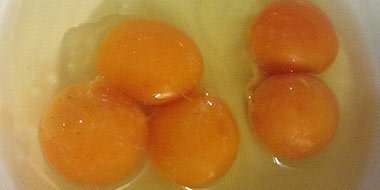
Double or multi yolk eggs, whilst very enjoyable, are actually a fault. They are common in young, laying hens, especially from hens that are from highly productive strains.
Soft, Thin or Missing Egg Shells
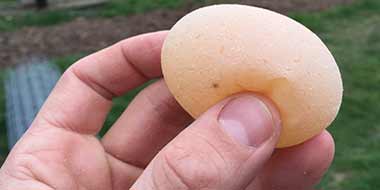
New chicken-keepers are often concerned when they find a soft-shelled egg, so this article aims to provide information about the causes of these strange eggs and provides some tips to preventing soft eggs.
Watery Egg Whites
As chickens get older, the quality of the egg that they lay will deteriorate. Older birds will lay eggs that have more watery albumen (what we call egg white). High egg producing strains (hybrid layers) seem to be more susceptible to this. It’s no surprise considering the number of eggs they lay in their early […]
Blood Spots in Eggs
Blood spots are usually found in or just next to the yolk of an egg. They are caused by a tiny blood vessel in the ovary that gets broken and leaves a small spot of blood next to the yolk as it passes through the oviduct of a hen. Highly active hens around the time […]
Meat Spots in Eggs
Meat spots in eggs are usually found in the albumen (white) rather than near the yolk like blood spots. They are brown in colour and are made up of small pieces of body tissue, from the lining of the oviduct. Meat spots appear more in older hens or hens with poor health but also vary […]
Calcium Coated Eggs
Sometimes an egg gets coated in calcium. It looks very white and powdery on the surface of the shell. Sometimes the egg can look a pinkish colour. Calcium coated eggs are usually caused by the egg staying in the shell gland for too long. Young hens that are stressed in some way can be susceptible […]
Wrinkled Egg Shells
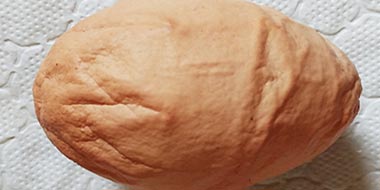
Sometimes chickens will lay a wrinkled egg. These are normal eggs inside, with hard shells, but have wrinkled egg shells. So what causes these wrinkled eggs? And are they safe to eat?
Bacterial Contamination
Bacteria exist on the surface of all eggs. Egg shells are porous, however there is a protective layer deposited around the shell of an egg when laid (which is why eggs can look wet when they are ‘just laid’). This is called the ‘bloom’ and it is natures way of stopping bacteria from entering the […]
The Reproductive System Of A Chicken
Before reading about reproductive system problems, it is helpful to understand how the reproductive system works, part of which includes egg laying. A hen’s reproductive system consists of two parts: the ovary and the oviduct. The ovary contains thousands of ova (see the diagram below) which can develop into the yolk and eventually an egg. […]
The Digestive System of a Chicken
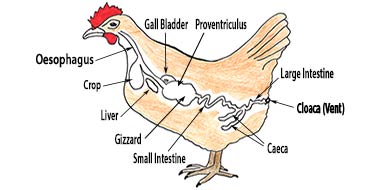
In this article, you will learn about the different parts of a chicken’s digestive system. There are also tips on what to expect from your chickens during normal feeding and digestion.
Mycoplasma Gallisepticum

Many backyard flocks these days are carrying Mycoplasma. There are many different kinds of Mycoplasma, but Mycoplasma Gallisepticum (M.G) is the most common.
Acute Heart Failure
Acute heart failure is commonly called a Heart Attack. This is more common in large fowl that have been bred for size, especially cock birds but also in hybrid broilers that put on weight quickly. For example, you keep large fowl Orpingtons and let your birds out in the morning, everything seems fine and then […]
Worming Ducks
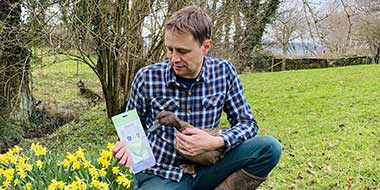
Ducks can carry worms, just like other poultry. Worming ducks (or de-worming, as some people say) is not difficult using a suitable worming product, but whether you need to worm ducks is often a question that comes up.
Keeping Cockerels Together Over Winter
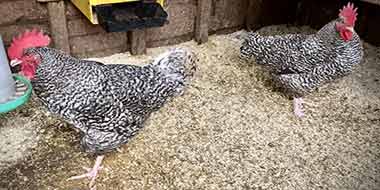
For easier management over the winter months, I keep my cockerels together. This is how I make the introductions without having too many feathers flying!
